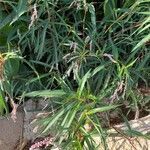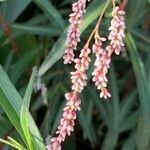Leaf lamina 8–27.5 × 3–8 cm, oblong-lanceolate to lanceolate, cuneate at the base and narrowing into the petiole, acute or long acuminate at the apex, with many ascending lateral nerves, glabrous apart from hairs on the midrib and margins to densely white-woolly on both surfaces, often more densely so on the lower surface, covered with small yellowish glands on the lower surface; petiole 1–5 cm long.
A robust herb. It keeps growing from year to year. It grows 3 m tall. The leaves are alternate and bright green. The flowers are in clusters on long spikes. They are pink. The fruit is a shiny black nut.
Ocrea reddish-brown, membranous, up to 3.5 cm long, apex truncate, usually without cilia, rarely with short cilia, glabrous or with a variable tomentum outside.
Stamens usually 7; filaments 2–5 mm long, filiform, dilated to the base; anthers 0.4–0.5 mm long, subglobose to ellipsoid.
Perianth rose-pink, greenish or white, 3–4 mm long, 4(5)-lobed, dotted with some orange glands; lobes 2–2.5 mm long.
Stems up to 3 m tall, glabrous to thickly and softly white-tomentose, sometimes rooting at the lower nodes.
Ovary 1.5 × 1.5 mm, compressed; styles 2, 1.5 mm long, united below the middle.
Nut smooth and shiny, 2.5–3.5 mm long, lenticular, with dimpled faces.
An erect robust perennial herb.



